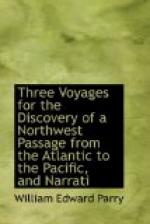[011] Cartwright’s Labrador, iii., 232.
[012] Ledyard. Proceedings of the African Association, vol i, p. 30.
[013] The first travelling boat, which was built by way of experiment, was planked differently from these two; the planks, which were of half-inch oak, being ingeniously “tongued” together with copper, in order to save the necessity of caulking in case of the wood shrinking. This was the boat subsequently landed on Red Beach.
[014] This article of our equipment contains a large proportion of nutriment in a small weight and compass, and is therefore invaluable on such occasions. The process, which requires great attention, consists in drying large thin slices of the lean of the meat over the smoke of wood-fires, then pounding it, and lastly mixing it with about an equal weight of its own fat. In this state it is quite ready for use, without farther cooking.
[015] The merits of this simple but valuable invention being now too well known to require any detailed account of the experiments, it is only necessary for me to remark, in this place, that the compass, having the plate attached to it, gave, under all circumstances, the correct magnetic bearing.
[016] It is remarkable, that the Esquimaux word for boot is very like this—Kameega.
[017] I find it to be the universal opinion among the most experienced of our whalers, that there is much less ice met with, of late years, in getting to the northward, in these latitudes, than formerly was the case. Mr. Scoresby, to whose very valuable local information, contained in his “Account of the Arctic Regions,” I have been greatly indebted on this occasion, mentions the circumstance as a generally received fact.
[018] It was probably some such gale as this which has given to Hakluyt’s Headland, in an old Dutch chart, the appellation of “Duyvel’s Hoek.”
[019] I have been thus particular in noticing the Hecla’s position, because our observations would appear to be, with one exception, the most northern on record at that time. The Commissioners of Longitude, in their memorial to the king in council, in the year 1821, consider that the “progress of discovery has not arrived northward, according to any well-authenticated accounts, so far as eighty-one degrees of north latitude.” Mr. Scoresby states his having observed in lat. 81 deg. 12’ 42”.
[020] Had we succeeded in reaching the higher latitudes, where the change of the sun’s altitude during the twenty-four hours is still less perceptible, it would have been essentially necessary to possess the certain means of knowing this; since an error of twelve hours of time would have carried us, when we intended to return, on a meridian opposite to, or 180 deg. from, the right one. To obviate the possibility of this, we had some chronometers constructed by Messrs. Parkinson and Frodsham, of which the hour-hand made only one revolution in the day, the twenty-four hours being marked round the dial-plate.




